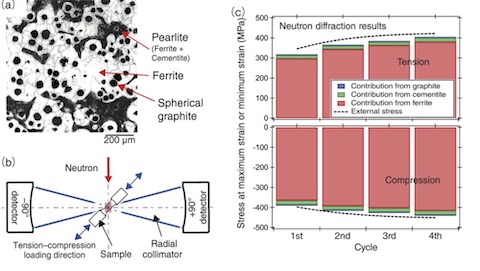
Fig.5-4 (a) Cast iron microstructure, (b) schematic of in situ neutron diffraction experiment, and (c) the obtained results
Cast iron is an iron-based material comprising three constituent phases (i.e., structures), as shown in Fig.5-4(a): ferrite, pearlite, and spheroidal graphite. Cast iron is known for its ability to withstand high external forces and can easily be cast into complicated shapes; it is thus widely used in the casing of hydraulic equipment for construction machinery, various parts of automobiles, and spent nuclear fuel casks. Cyclic tensile-compressive deformation tests are often performed to simulate use in a harsh environment. Although the strength of cast iron is known to increase with increasing cycle number during cyclic tensile-compressive deformation, the mechanism behind this increase in strength has remained unclear.
Therefore, an in situ neutron diffraction experiment was designed to observe the forces and microstructural changes occurring in each of the constituent phases of cast iron and clarify this mechanism; a schematic of this experiment is shown in Fig.5-4(b). Here, the stress (strength) and crystal defects carried by each constituent phase could be obtained in diffraction experiments using neutrons with high penetrating power by quantitatively analyzing the diffraction lines related to the atomic arrangement of each constituent phase inside the sample.
The obtained results are summarized in Fig.5-4(c). As the number of cycles increased during the cyclic tensile-compressive deformation test, crystal defects (i.e., dislocations) accumulated in ferrite, thus increasing its strength. This increase in strength led to an increase in the overall strength of the cast iron, because ferrite was the major constituent phase in the cast iron. On the other hand, the cast iron contained a very small fraction of cementite (a constituent of pearlite), so its contribution to the overall strength was limited. Additionally, spheroidal graphite accommodated low stress and thus provided only a negligible contribution to the strength.
Overall, a detailed analysis of the behavior of each phase of cast iron was analyzed in detail via diffraction using the high-intensity pulsed neutron beam of the Materials and Life Science Experimental Facility at J-PARC, thereby allowing us to successfully elucidate the mechanism behind strength increases during cyclic tensile-compressive deformation. Further, the method developed using the TAKUMI diffractometer enabled in situ neutron diffraction experiments during continuous deformation.
Cast iron is an important material supporting daily life; by changing the morphology and distribution of the constituent phases by heat treatments or other processes, a wide range of material properties can be tuned to cover a wide range of applications. Our achievements toward understanding the phenomena occurring in cast iron may advance calculation and processing methods and support the design of materials for various applications.
This study was supported by the Japan Society for the Promotion of Science (JSPS) KAKENHI Grant-in-Aid for Scientific Research on Innovative Areas (Research in a proposed research area) (No.JP18H05479) “Solving kink formation/strengthening mechanism through precise structure analyses”.
(Stefanus Harjo)